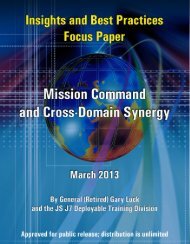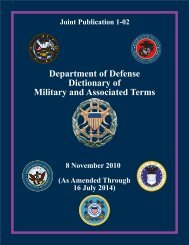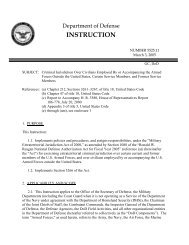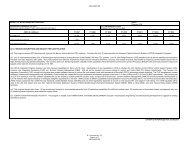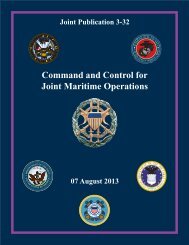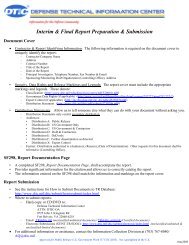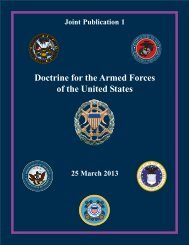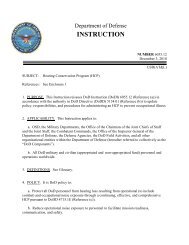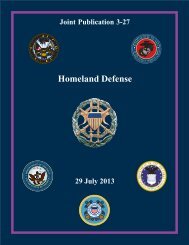JP 3-16, Multinational Operations - Defense Technical Information ...
JP 3-16, Multinational Operations - Defense Technical Information ...
JP 3-16, Multinational Operations - Defense Technical Information ...
Create successful ePaper yourself
Turn your PDF publications into a flip-book with our unique Google optimized e-Paper software.
Planning and Execution Considerations<br />
Forces Command, have developed and exercised intelligence policies and procedures that<br />
provide examples of how multinational planning can be done in advance.<br />
(4) Share All Necessary <strong>Information</strong><br />
(a) Coalition members should share all relevant and pertinent intelligence<br />
about the situation and adversary consistent with national disclosure policy (NDP) and<br />
theater guidance. However, information about intelligence sources and methods should not<br />
be shared with coalition members unless approved by the appropriate authority.<br />
(b) Force protection is a mission inherent to any commander, and intelligence<br />
support to that mission is critical. Every effort must be made to share any data that could<br />
impact the commander’s force protection mission.<br />
(c) When information relating to a particular source cannot be shared, the<br />
intelligence derived from that source should still be provided to other multinational partners<br />
if at all possible. The intelligence directorate of a joint staff (J-2) should establish procedures<br />
for separating intelligence from sources and methods. Intelligence agencies often produce<br />
highly classified reports that contain compartmented information. To the greatest extent<br />
possible, this information should be disseminated using a tear line. A tear line enables the J-<br />
2 and Service component intelligence elements to keep information above the tear line<br />
(compartmented data) and disseminate the intelligence below. Having intelligence<br />
production agencies use such tear lines should facilitate intelligence sharing. Such<br />
considerations warrant increased emphasis for forces operating at the tactical level where<br />
timely information is especially critical to mission success as well as prevention of friendly<br />
fire and undesired collateral damage. When feasible, intelligence production organizations<br />
operating in a multinational environment should implement a write for release without<br />
dissemination restrictions policy to facilitate timely dissemination of tactical intelligence<br />
partner organizations.<br />
(d) The joint force J-2 should obtain the necessary authorizations from the<br />
foreign disclosure officers (FDOs) and designated intelligence disclosure officials (DIDOs)<br />
from the CCMD J-2 or FDO as soon as possible. J-2 personnel should be knowledgeable of<br />
the specific foreign disclosure policy, procedures, and regulations for the operation. The<br />
assignment and use of qualified and certified FDOs and DIDOs are vital to safeguarding<br />
classified information from inadvertent disclosure and will enhance the efficient flow of<br />
intelligence.<br />
(5) Conduct Complementary <strong>Operations</strong><br />
(a) Intelligence efforts of the nations should be complementary. Each nation<br />
will have intelligence system strengths and limitations and unique and valuable capabilities.<br />
HN security services’ capabilities, for example, may contribute significantly to force<br />
protection. Furthermore, planning with friendly nations to fill shortfalls, especially linguist<br />
requirements, may help overcome such limitations.<br />
(b) All intelligence resources and capabilities should be made available for<br />
application to the whole of the intelligence problem. Establishing a multinational collection<br />
III-15



